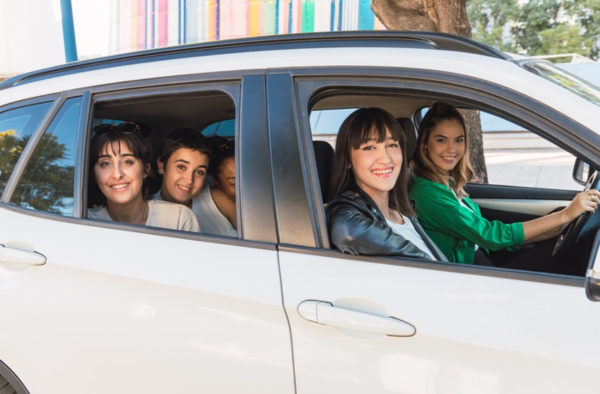Back-to-school season is underway and Michigan’s roads are flooded with student-commuters making their way to and from school every day.
As exciting of a time as this can be for new drivers, it’s important to always drive safely and legally – especially when the slightest misstep can cause insurance rates to skyrocket!
In this blog, we’ll break down Michigan’s Graduated Driver Licensing (GDL) System and highlight the key restrictions it places on newly licensed teen drivers.
Michigan’s Graduated Driver Licensing (GDL) System
In Michigan, licensed drivers are broken down into categories based on age and experience. These categories and corresponding license levels are what’s commonly referred to as the Graduated Driver Licensing (GDL) system.
If you have a teen driver at home and they’re making their way to school by themselves, they should be in possession of a Level 2 Intermediate License. In order to reach this license level, your student driver must have completed a driver’s training program (segments 1 and 2) and logged at least 50 hours of supervised driving (with at least 10 night hours).
Restrictions for Teen Drivers (With Level 2 Intermediate License)
Sixteen and Seventeen year old drivers are some of the most at risk drivers for accidents. Due to their relative immaturity and inexperience, drivers this age are subject to certain restrictions via the GDL system.
You may now be thinking to yourself, “How exactly is a Level 2 Intermediate License driver restricted?” Here’s a breakdown of all the relevant restrictions (pulled directly from the GDL parent guide):
- Drivers in possession of a Level 2 Intermediate License shall not operate a motor vehicle between 10 p.m. and 5 a.m. except when:
- driving to or from or in the course of employment
- driving to or from an authorized activity
- accompanied by a parent or legal guardian or a licensed driver 21 years of age or older designated by the parent or legal guardian.
- Drivers in possession of a Level 2 Intermediate License shall not operate a motor vehicle at any time with more than 1 passenger in the vehicle who is younger than 21 years of age except:
- when the additional passengers are immediate family members
- when driving to or from, or in the course of employment
- while going to or from an authorized activity
- when accompanied by a parent or legal guardian or a licensed driver 21 years of age or older designated by the parent or legal guardian.
- Authorized activities include:
- A school or a school-sanctioned event or activity. School means a public or private school, including a home school.
- A sporting event or activity, or extracurricular event or activity, that is not school-sanctioned but that is part of an official sports league or association or an official extracurricular club, or that is paid for as a service offered by a business specializing in those events or activities or training for those events or activities.
- A class or program of vocational instruction offered by a college, community college, nonprofit association, or unit of government or by a business specializing in vocational training.
- An event or activity sponsored by a religious organization that is tax-exempt under federal law.
- Transporting an individual in need of immediate emergency care or personal protection to a health-care professional, hospital, police station, domestic violence shelter, or public safety location.
According to the GDL parent guide, these restrictions are, “designed to help teens gradually and safely build their skills and experience behind the wheel and are responsible for 20- to 40-percent reductions in teen crashes.”
In addition to the restrictions listed above, teen drivers are not allowed to use their cell phones while driving – just as all other drivers in Michigan following June 30, 2023.
By following these restrictions and practicing defensive driving, your teen driver will not only be keeping themselves and others on the road safer, but will also keep their auto insurance rates low and manageable.
Steps Beyond Level 2 Intermediate License
After successfully completing 12 consecutive months of driving free of any restriction-violations, at-fault accidents, or traffic tickets, your teen driver will qualify for a Level 3 License.
No restrictions exist for drivers with a Level 3 license. However, if you feel your teen is not ready for this level of freedom and responsibility, you can restrict or cancel your teen’s Level 3 License through the Secretary of State.
Drivers are eligible for their Level 3 License starting at 17 years old. Once a driver reaches 18 years old, they will automatically move into a Level 3 License, unless they had not yet graduated to a Level 2 License.
If a driver reaches 18 years old and still only has their Level 1 Learner’s License, they will lose their license and all driving privileges, and will need to follow the procedures for applicants who are age 18 and older.
Get David Get Paid
Insurance companies will do everything they can to avoid compensating you following an accident. Don’t let them take advantage of a teen driver listed on your insurance policy.
The team of top-notch personal injury attorneys at Femminineo Law will make the best case for your teen driver in court, and will ensure that they are not held liable solely due to their age and inexperience.
If you or a loved one was recently in an accident, give us a call at 855-65-CRASH or visit our website at www.getdavidgetpaid.com, today!



